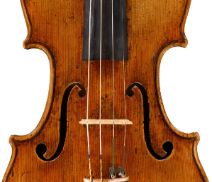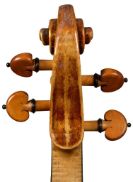Violin, Giuseppe Guarneri filius Andreae, Cremona, after 1732, “ex Guilet”
Printed label: “Ioseph Guarnerius Filius Andreæ Fecit / Cremonæ, sub Titulo S. Theresię 1715” (15 handwritten)Although the printed label in the instrument is not original, the violin is attributed to Giuseppe Guarneri filius Andreae, who died in 1740, by virtue of its stylistic features. According to a dendrochronological report, the youngest tree ring of the belly was dated 1732. Therefore, the instrument must have been made in the last years of Guarneri’s life. Today, musicologists assume that Guarneri built only few instruments of his own during this period and mainly assisted his son, Giuseppe Guarneri del Gesù. The highly arched, powerful model of this violin is clearly distinct from the work of del Gesù in terms of body contours and the position of the f-holes. The two-piece belly has regular, medium-wide annual rings with a faint hazel figure. The one-piece, quarter-cut back has tight flames sloping downward slightly toward the bass side. A narrow wing has been added on the treble side. The rib wood is also quarter cut and features broader flames. The violin has elegantly curved f-holes with large, somewhat variably executed lower eyes. Its sturdy edge is bounded by a somewhat irregularly implemented purfling. The very powerful scroll still shows conspicuous toolmarks. An orange-reddish brown color varnish lies over a golden-yellow ground. The overall condition of the instrument is good. The violin features one construction detail that is typical of violinmakers in the tradition of Nicolò Amati and that can be found on the violins of all members of the Guarneri dynasty: The backs of these instruments have a small, conical hole in the acoustic center of the instrument, about 19 cm above the bottom end. Frequently, these holes are visible only on an X-ray or CT-scan image. While the purpose of these holes has not been established with certainty, they were presumably made before the back was thinned, so that the luthier could control the thickness of the wood.
This instrument’s history can be traced to violinmaker Louis Fernand Billottet (1895–1947), who sold it to violinist Daniel Guilet (1899–1990). Born in Rostov as Daniel Guilevitch, Guilet grew up in Paris and studied with George Enescu at the Paris Conservatory. In 1941, Guilet emigrated to the USA, where he held the position of concertmaster of the NBC Symphony Orchestra under Arturo Toscanini. Guilet was a founding member of the famous Beaux Arts Trio. The Guarneri violin was his concert instrument from 1965 until 1973, when it was sold to Herbert Richard Axelrod, who then loaned it to Henryk Szeryng, David Oistrakh and Joshua Bell.












